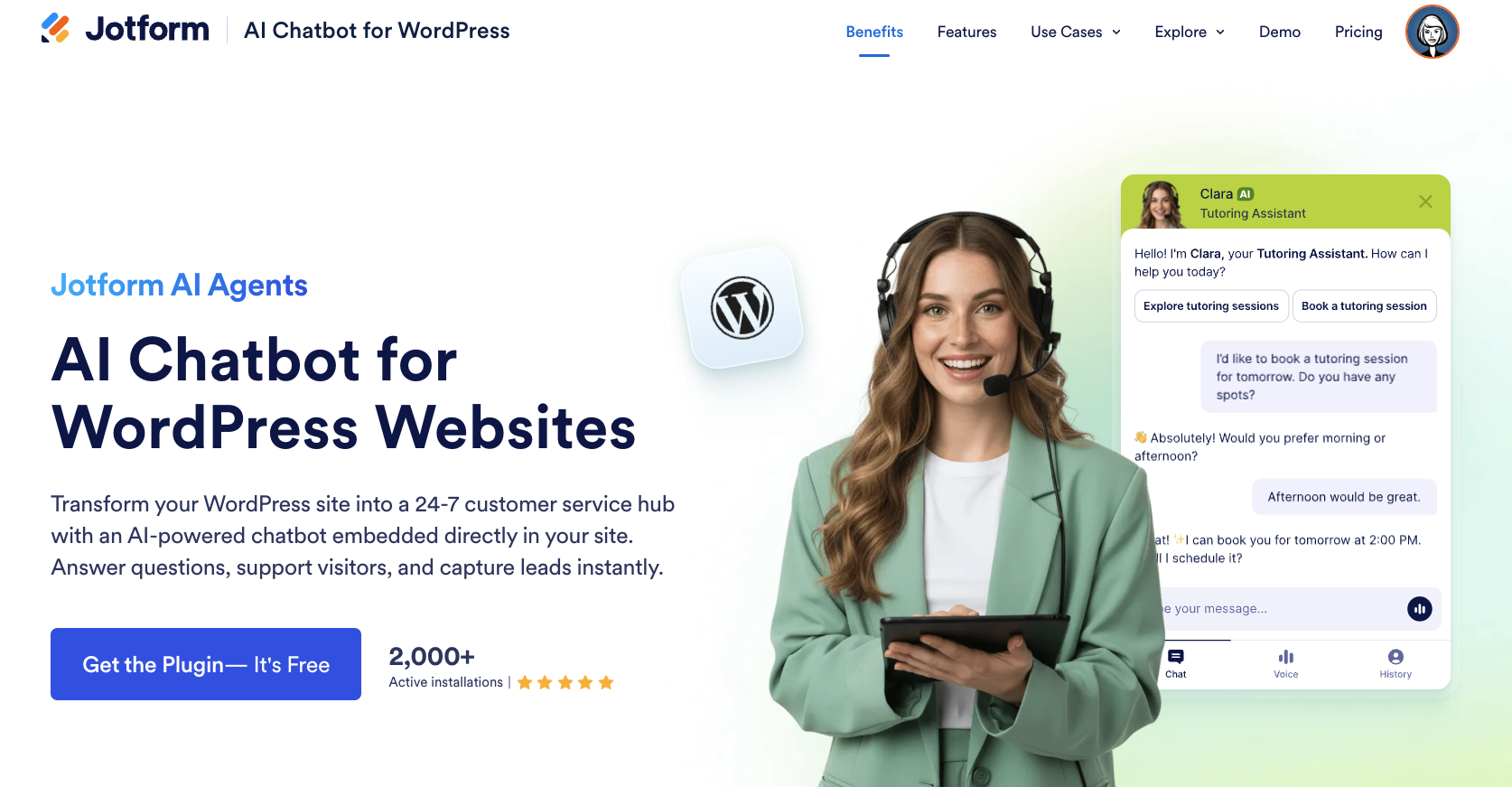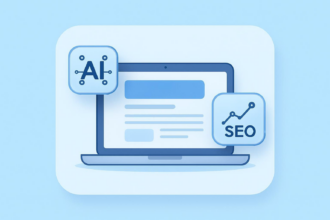10 practical methods to use AI in WordPress
- Greet visitors with a custom AI chatbot
- Create AI-generated images
- Generate blog posts with AI writing plugins
- Improve search engine optimization (SEO) with AI
- Use an AI builder to design an entire website
- Fight spam an AI security plugin
- Automatically write product descriptions
- Translate your content into different languages
- Create interactive AI forms
- Win back abandoned carts with AI reminders
Anyone can use a WordPress template and its drag-and-drop editor to build a basic site in a weekend. But for fancy features like conversational chatbots, you either need to pack your bags for coding boot camp or hire a professional. Or save your bank account with a third option: AI WordPress plugins.
This software lets you add AI features to your WordPress site. Native AI plugins are designed to work with WordPress from the very beginning, so they’re usually more compatible than outside AI-powered services. Use them for everything from tweaking product descriptions to translating your services page into French.
Of course, you shouldn’t start downloading random AI plugins randomly. That just wastes time and bogs down your site. Instead, choose just a handful of AI plugins that fit your goals and technical skills. This guide walks you through how to use AI in WordPress to grow your business.
How to use AI in WordPress: 10 practical methods
The best AI WordPress plugins can turn a clunky, confusing site into a top-tier selling machine. They also save time by handling some of the more tedious parts of web design. Instead of spending days painstakingly writing product descriptions or answering the same five customer questions, let AI do it for you.
1. Greet visitors with a custom AI chatbot
For shoppers, there’s nothing more annoying than waiting in a miles-long customer service queue to ask about a return or delivery date. Get them answers faster with the Jotform AI Chatbot for WordPress. This handy little assistant is always ready to chat with visitors, even when your human team is off the clock.
Learning how to use Jotform AI chatbot on WordPress is straightforward. Once you’ve installed and activated the plugin on your WordPress site, you can customize your chatbot. Give it an adorable name and avatar, like Jotform’s starry-eyed Podo AI Agent. You’ll also train the AI chatbot by feeding it documents, questions and answers, and web pages. The bot will memorize your content and use it to have fluid conversations with customers. And again, no coding necessary.
Sample workflow: An e-commerce website uses the Jotform AI Chatbot for WordPress for front-line customer service. It links the bot to its WooCommerce store, so the chatbot can answer questions about product details and availability. For more complex questions — like “Can I customize the number of loops on this dog collar?” — the chatbot connects the customer to a human representative.
Pros: Offers speedier customer service, especially during flash sales and other busy events; frees up your human team to focus on problems that require more creativity and empathy; easy to scale; always available
Cons: Can’t always assist with more complex queries
2. Create AI-generated images
Customers love visuals, but finding the perfect stock photo for every blog post and Facebook ad isn’t easy. And taking photos or videos yourself can easily turn into a full-time job. Save time with an AI WordPress plugin like SeedProd. It generates images based on written prompts, such as “Create a close-up photo of a hand brushing an orange cat.”
Customers sometimes view AI images as uncanny, so don’t use this tool for every visual. But, when used strategically, SeedProd and other AI generators can fill in the gaps in your WordPress media library and help you avoid using the same tired stock photos.
Sample workflow: A beauty company uses prompts to generate diverse visuals for its blog. For a post about natural toothpaste, for instance, the marketers ask SeedPro’s AI agent, “Can you create an image of a smiling Black woman brushing her teeth in a mirror?” Before publishing, the human team thoroughly analyzes each visual for strange hallucinations, such as six fingers on the woman’s hand or a toothbrush with brushes on each end.
Pros: Much faster than creating visuals from scratch; more affordable than hiring a professional photographer or videographer; get exactly what you need instead of relying on random stock photos
Cons: Some AI images may look uncanny or have weird abnormalities
3. Generate blog posts with AI writing plugins
Writing well-researched blog posts can draw more visitors and turn your site into a go-to resource. But it’s one of the most time-consuming types of content marketing. Drafting, editing, double-checking if you need a comma there — before you know it, you’re spending hours on each post.
Protect your creative energy with Bertha.ai. This copywriting tool uses AI to generate everything from meta descriptions to full posts. Use it to speed up outlining and spin up first drafts. Then, your human creators can add their original experiences and in-depth research. That way, your content still has a distinct voice and true value.
Sample workflow: In the build-up to a major product launch, a pet food company publishes a series of blog posts about trendy new ingredients in kibble. It uses Bertha.ai to draft the content, which human editors thoroughly fact-check. The team also adds anecdotes and quotes from real veterinarians so the posts don’t feel generic.
Pros: Less expensive than hiring full-time marketers or freelance writers; can write a blog post in minutes instead of hours; many tools let you train the AI generator to use your brand voice; scalable
Cons: AI sometimes shares incorrect or downright dangerous information, so review everything
4. Improve search engine optimization (SEO) with AI
SEO has countless rules, from using the right keywords to adding the perfect number of internal links. Luckily, AI SEO WordPress plugins like All in One SEO can handle a lot of the heavy lifting. Use them to analyze your on-page SEO and get recommendations to make your site more readable. All in One SEO also suggests keywords and adds schema markup, which helps search algorithms understand if you’re sharing a recipe or an article.
Sample workflow: A bakery uses AI SEO tools to add local keywords to its WordPress site. It also uses All in One SEO to audit its content and fix small issues that are sneakily hurting its rankings. For instance, if all those photos of delicious cakes are slowing down loading times, the AI plugin may recommend compressing them.
Pros: Analyzes your site’s SEO performance, so you can see what’s working and what’s falling short; automates tedious SEO tasks, like writing meta descriptions and tweaking formatting; speeds up link building; some tools reveal your competitors’ SEO strategies
Cons: Keyword recommendations may be biased or nonsensical, such as “apple picking best farm upstate New York apples”
5. Use an AI builder to design an entire website
Okay, so maybe you don’t even have a website yet. No problem. Describe your perfect website to WordPress’s AI Website Builder, and it will spin up a new one in minutes. No more obsessing over layouts or whether your menu buttons should be green or gray. Once you’ve got a solid foundation, add custom content and fine-tune the aesthetic to fit your brand.
Sample workflow: A B2B business uses AI-powered web design software to create the bones of its website. The tool designs a mobile-friendly layout and suggests the best layout. Then, the team fills in the site with branded content and tweaks the aesthetics to appeal to professionals.
Pros: Much faster than building a website from scratch; handles technical details, such as SEO, so you can focus on attracting clients; no coding skills necessary; significantly less expensive than hiring a professional web designer
Cons: Less control and freedom than hiring a professional web designer
6. Fight spam an AI security plugin
Have you ever seen a blog post with hundreds of nonsensical comments at the bottom? That content has been targeted by spammers. It’s not a good look, especially if your business is trying to build a strong reputation. Visitors may assume you’re not taking care of your site or, even worse, get a virus if they click a malicious link in your comments section.
Protect your clients and your reputation with Akismet’s anti-spam plugin. It uses AI to automatically scan every submission to your site and filter out malicious content. That way, you won’t have to waste time manually deleting an avalanche of spammy comments.
Sample workflow: Spammers have targeted a small business’s WordPress site, flooding the comment sections. The company installs Akismet’s plugin to filter out spam and take back control.
Pros: Quickly weeds out spam comments before they ever reach your audience; protects your site 24/7, so you don’t have to obsessively check your comments sections; safeguards your reputation
Cons: May filter out a few legitimate comments
7. Automatically write product descriptions
If you sell products, you already know that persuasive yet accurate descriptions are key. After all, customers won’t buy a product if they can’t even figure out what it does. But you also don’t want to mislead your audience with exaggerated write-ups. That’s a fast track to negative reviews and returns.
Strike the right balance with a WooCommerce AI plugin. AI Power, for instance, can automatically turn product data into high-quality descriptions. Instead of spending hours trying to find the right words to describe a coffee pot or hiking poles, you can let AI churn out the first draft.
Of course, the work isn’t over once you’ve posted the finished descriptions. The Jotform AI Chatbot for WordPress uses AI to crawl your product pages and automatically update information. Did you decide to discontinue a certain clothing size? Or do you want to highlight that your products are sustainable? The Agent will automatically update your product pages, so you don’t have to comb through each one.
Sample workflow: A fashion retailer only has a few days to write hundreds of product descriptions for its spring clothing line. The marketing team feeds AI Power a spreadsheet filled with basic product details, then uses it to generate a blurb for each item. A human checks each write-up for accuracy and bias before posting it to the product store.
Pros: Helps launch products faster, so you can start making sales; lightens the marketing team’s workload; uses machine learning algorithms to identify the most persuasive keywords and benefits
Cons: Like any AI-generated content, you should fact-check these descriptions for outrageous claims, like “This mop will remove any stain from your tile floors!”
8. Translate your content into different languages
As your business grows, it’s natural to want to expand into new markets. But if your WordPress site is only written in one language, you’re limiting your opportunities. An AI translator plugin can help you connect with new audiences in their own language.
WordPress Multilingual, for instance, uses AI to translate web pages, metadata, and other content. You can automatically translate every page or manually select which content to convert. It also links together translated content, so you don’t have to worry about someone reading a blog post in French, then clicking on a product page in Swedish.
Sample workflow: A hotel draws international visitors from English-speaking countries and wants to reach even broader global audiences. It uses an AI translation tool to convert its site into new languages and optimize it for multilingual SEO. That way, international visitors can actually discover all that translated content
Pros: Less expensive and time-consuming than hiring a translator for the entire process; allows you to grow your audience; makes your WordPress site more inclusive
Cons: AI may mistranslate some content and doesn’t always understand context, so consider hiring an editor who’s fluent in both languages
9. Create interactive AI forms
Even the most straightforward forms can sometimes trip up visitors. With the Jotform AI Chatbot for WordPress, an AI assistant is always on hand to guide users through your forms. It answers questions and gives instructions conversationally. If someone is confused about how to fill out a particular field, the Agent will help to make sure you collect the correct information.
Sample workflow: A community center designs AI registration forms for upcoming classes. It trains the Agent with its FAQ page so it can answer common questions, such as, “Which name should I put down if I’m signing up my child?”
Pros: Gathers more accurate and complete data than non-interactive forms; reduces the time your team spends answering basic questions; improves the customer experience
Cons: Takes time to train the AI
10. Win back abandoned carts with AI reminders
In a perfect world, people would add products to their cart and immediately click “check out.” But sometimes, customers second guess purchases — “Do I really need another Christmas sweater?” — or get distracted by the Teams notification. With Jotform’s AI Chatbot for WordPress, you can send those wayward clients a friendly reminder email.
Sample workflow: A book retailer uses a pop-up AI form to gather visitors’ contact information in exchange for a small discount. If clients abandon their carts, the AI plugin detects this inactivity and sends a reminder email the next day.
Pros: Increases lead retention; can boost sales by encouraging shoppers to finish their purchase; reduces the time your sales team spends chasing down leads
Cons: Too-frequent reminders may annoy customers
Level up your entire website with Jotform AI Chatbot for WordPress
Forget about studying the intricacies of machine learning. With plugins and no-code tools, you can easily add AI to your WordPress site.
Get started by testing a few AI plugins to see what fits your workflow. For the best results, pair these native workflows with the Jotform AI Agent. It allows you to automate support, engage visitors, and more.
Don’t be afraid to experiment, either. Who knows? That intriguing new plugin could be just what you need to climb the search rankings or boost sales.
FAQs
Use content AI plugins to brainstorm ideas and generate first drafts. Instead of writing an entire blog post from scratch, you can generate copy and polish it.
If you only have time to set up one AI plugin, try Jotform’s AI Chatbot for WordPress. It includes advanced features like conversational chatbots, cart recovery, and the ability to brand the Agent.
This article is for WordPress site owners, content creators, and digital marketers who want to streamline content creation, SEO, customer support, and e-commerce workflows using AI-powered plugins and tools.










Send Comment: